A few days back, I had written about my interaction with two Bengali immigrant children as I biked past Bellandur Lake. These two children were happily playing with the Bellandur ‘snow’ unaware of the health risks that their games posed to them.
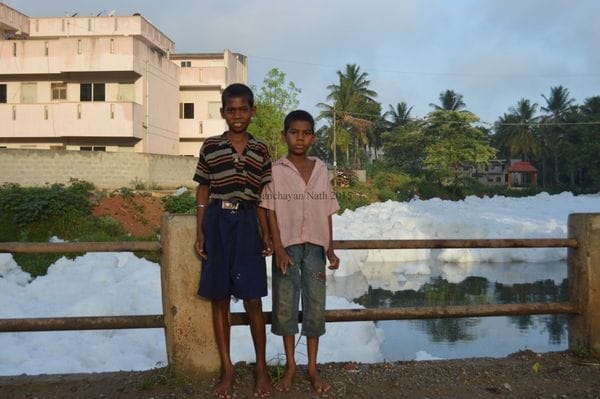
Pic: Sanchayan Nath
That day, I was on my way to Kaikondrahalli Lake where I wanted to spend some time before biking to Puttenahalli Lake in JP Nagar.
As I walked around the Kaikondrahalli Lake, I came across two other children. In contrast to the two children I had met near the Bellandur Lake, the young lady and the young gentleman I met at the Kaikondrahalli Lake, appeared to be from fairly affluent families.
The young lady and her mom (I assume it was her mom) were taking a leisurely walk around the lake. Suddenly, her mom turned towards the lake, and pointed out to her daughter: “Look at the birds!” The daughter immediately clung onto the metal fencing around the lake, and as she watched birds play on the water, her face broke into a huge smile.
A few minutes later, as I began to walk towards the other end of the lake, I met a young gentleman lost in deep concentration. His attention appeared to be focused on the screen of the camera in his hands. Every few minutes, his dad (I assume it was his dad) would exclaim: “Look, a bird is flying!”, and the young gentleman’s fingers would immediately go Click! Click! Click!
Later that day, as I biked back to my friend’s apartment, I was reminded of all the children I had met as I walked around the Vibhutipura lake, which is close to his home.
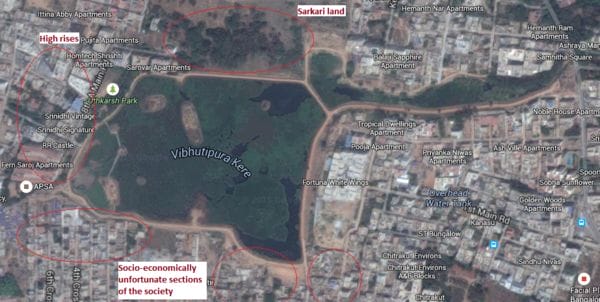
Source: Google maps
For a researcher interested in lake governance issues, Vibhutipura Lake is a fascinating case-study. On various tracts of the land found around the lake, one can find people residing in high-rise apartments. A section of society that is not socio-economically fortunate lives on some parts of the land. Certain tracts of land around the lake belong to sarkari agencies as well.
For most urban dwellers, a lake located in the vicinity of their residence probably serves three different uses – ground water recharging (We are sick and tired of buying water from the tankers!), health benefits (I am preparing for a Marathon, I better get back to shape!), and aesthetic appeal (Wow! Look! Such a romantic sunset!).
As I began to spend time around Vibhutipura Lake, what amazed me was the wide variety of ‘things’ that ‘people’ appeared to be ‘doing’ around this particular lake.

Pic: Sanchayan Nath
Some children love playing with their slings as they walk around the lake. But, this use raises an interesting dilemma: Is this safe for the birds?
On the other hand, some children love sitting on the metal fence around the lake. The fence also provides an additional benefit – it is used to hold kite-flying equipment while taking a break from the sport. This too raises an interesting question: Are we allowed to sit on the fence?

Pic: Sanchayan Nath
Sometimes, I have seen fishermen hard at work in the lake. What caught my attention was the sense of purpose with which the hands of the fisherman moved, as he cast the net into the water, and the almost synchronised rapidity with which the boatman thrust his oar into the water.
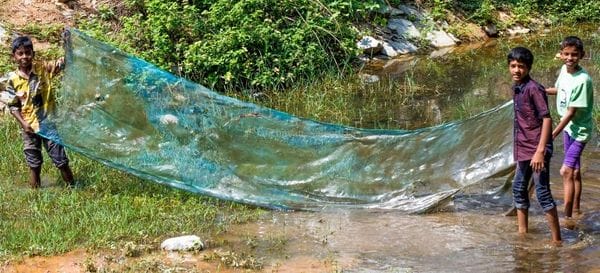
Pic: Sanchayan Nath
At other times, I have seen children playing ‘fishing-fishing’ in the lake.
This raises another question: Is it safe to fish in a lake which witnesses periodic release of sewage and effluents in its waters?

Pic: Sanchayan Nath
Sometimes dogs are walked around the lake by men on scooties. Please note that the dog-leash is fastened to the back of the vehicle. While walking a dog is allowed in the premises of this lake, motor vehicles are not!
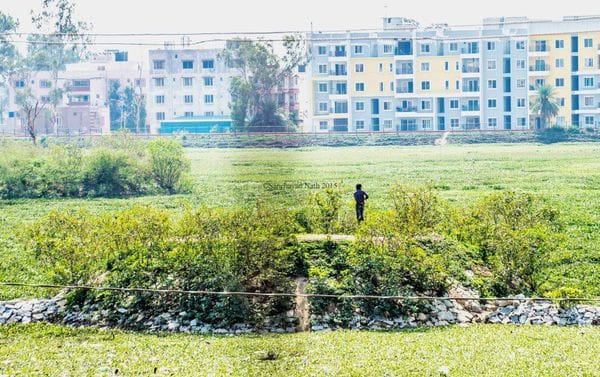
Pic: Sanchayan Nath
Some people like doing their mid-day potty on an island of this lake. This person waits till 9.45 am when all the walkers and joggers have returned home, does his thing and then solemnly walks back, lost in deep thought! If the islands were designed to provide some peace and quiet for the birds who visit the lake, where do humans perform their daily excretory functions, when there are no toilets at home?
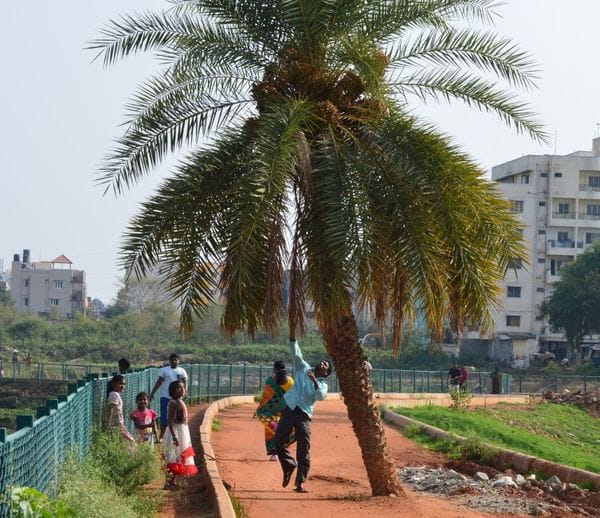
Pic: Sanchayan Nath
Some people love ‘plucking’ fruits for the children in their neighbourhood from trees located in the premises of the lake.

Pic: Sanchayan Nath
For others, the premises of the lake provides space for performing certain social functions which cannot be performed at home. In this photo for instance, a young lad appears to be getting his hair cut under a tree located near the lake.
While the usage of the space in and around this lake is characterised by various social dilemmas, the performance of important lake maintenance functions around this lake too poses significant management dilemmas.
For instance, consider the following photo:

Pic: Sanchayan Nath
The lake is almost entirely covered with water-hyacinth. This photo illustrates the lake-cleaning activity in progress. The water hyacinth is removed manually from the lake and is then dumped near the edge of the lake. As the pile grows larger and larger and as it begins to spill-over into the walking track, a JCB is used to shift this pile of dump from one side of the lake to the other.
Or, consider the next photo:

Pic: Sanchayan Nath
Since the BBMP elections are due in a few months, there appears to be a new-found urgency to clean up the drains around the lake. Poorer sections of society live on land, in the buffer zone around the lake, which is rented out to them by an encroacher. So there is no space to dump the debris from the storm water drains, ‘outside’ the premises of the lake. The only alternative appears to be to leave them right on the walking track around the lake. Therefore, people who were using the premises for jogging, walking or as a thoroughfare, are now cut-off from their regular haunt.
The children who live in these houses however, do not appear to be too bothered by the dirty, almost-Ganges-like stream that appears to be flowing past their houses; or, by the huge almost-Kanchenjunga-like pile of debris that lies right outside their bedroom windows. They appear to be busy in their own world, probably playing a new game which can only be played in such unique circumstances.
As I walk past the Vibhutipura lake, I often pass by the following wall-painting –

Pic: Sanchayan Nath
In my eyes, the wall-painting depicts a future in which a tree-less Bangalore is on flames under the effects of a blistering sun. A red-colored liquid appears to be slowly engulfing the sky-scrapers that characterise the lake-less city.
One of my respondents once told me something to the tune of, “When I see the Raja Kaluves that connect the lakes to one another in Bangalore, I am reminded of Venice. I try to visualise how it must have been when pure water used to flow through them, and my vision for the city is that the Raja Kaluves in Bangalore perform the same role that the streams play in Venice”.
I dedicate this article to my visionary respondent – here’s to a future where your vision comes true!